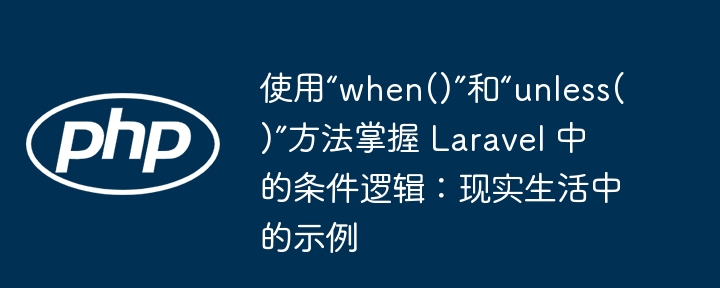使用“when()”和“unless()”方法掌握 Laravel 中的条件逻辑:现实生活中的示例(示例.逻辑.现实.条件.方法...)

Laravel 以其简洁的语法和强大的功能而闻名,其11.35.0版本引入的when()和unless()方法更是锦上添花。它们是Conditionable特性的组成部分,提供了一种更清晰、更高效的方式来处理条件逻辑,从而提升代码的可维护性。本文将通过实际案例,展示如何在Laravel应用中运用这些方法简化复杂的条件逻辑。
1. 动态角色分配假设您正在开发一个用户注册表单,用户可以选择角色。系统需要根据角色的不同,分配不同的权限。
无when()方法:if ($request->has('role')) {
$user->assignRole($request->input('role'));
}
使用when()方法:
$user->when($request->has('role'), function ($user) use ($request) {
$user->assignRole($request->input('role'));
});
when()方法使得代码更简洁,只有当条件成立时,代码块才会执行。
2. 动态验证规则假设您有一个表单,某些字段的验证规则取决于其他字段的值。例如,只有当用户选择订阅新闻时,才需要验证邮箱地址。
无when()方法:$rules = [
'email' => 'nullable',
];
if ($request->has('newsletter')) {
$rules['email'] = 'required|email';
}
$request->validate($rules);
使用when()方法:
$request->when($request->has('newsletter'), function () use ($request) {
$request->validate([
'email' => 'required|email',
]);
});
使用when()方法,条件验证逻辑更清晰易懂。
3. 条件数据合并在电商平台中,只有当用户提供有效的优惠券码时,才应用折扣。
无when()方法:$data = [
'total_price' => $cart->totalPrice(),
];
if ($request->has('coupon_code')) {
$coupon = Coupon::where('code', $request->input('coupon_code'))->first();
if ($coupon) {
$data['discount'] = $coupon->discount_amount;
}
}
return response()->json($data);
使用when()方法:
$data = [
'total_price' => $cart->totalPrice(),
];
$data = $data->when($request->has('coupon_code'), function ($data) use ($request) {
$coupon = Coupon::where('code', $request->input('coupon_code'))->first();
if ($coupon) {
$data['discount'] = $coupon->discount_amount;
}
return $data;
});
return response()->json($data);
when()方法使条件折扣的应用更简洁流畅。
4. 简化用户状态条件逻辑假设系统需要根据用户状态(激活或未激活)发送不同的消息。
无unless()方法:if (!$user->isActive()) {
return "您的账户未激活,请联系客服。";
} else {
return "欢迎回来!";
}
使用unless()方法:
return $user->unless($user->isActive(), function () {
return "您的账户未激活,请联系客服。";
})->otherwise(function () {
return "欢迎回来!";
});
unless()方法将条件逻辑压缩到一个return语句中,使代码更紧凑。
5. when()和unless()组合使用when()和unless()可以组合使用,处理更复杂的条件流程。例如,根据用户类型(管理员或访客)显示不同的内容。
$variable->when($user->isAdmin(), function ($variable) {
return $variable->adminDashboard();
})->unless($user->isAdmin(), function ($variable) {
return $variable->guestDashboard();
});
总结
通过以上案例,我们可以看到when()和unless()方法在Laravel中简化条件逻辑的强大能力。它们使得代码更易读、更易维护,并提升了代码的整体优雅性。 在实际开发中,合理运用这些方法,可以显著提高开发效率和代码质量。
以上就是使用“when()”和“unless()”方法掌握 Laravel 中的条件逻辑:现实生活中的示例的详细内容,更多请关注知识资源分享宝库其它相关文章!
